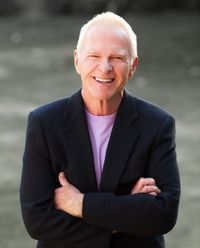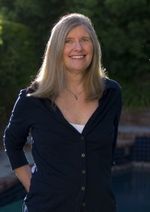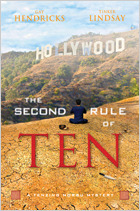Author R&R with Gay Hendricks & Tinker Lindsay

Gay Hendricks

Tinker Lindsay
Relationship expert Gay Hendricks and his wife (Dr. Kathlyn Hendricks) have written relationship bestsellers such as Conscious Loving and The Conscious Heart. When Gay Hendricks decided to turn to the mystery/thriller genre, he partnered with Hollywood screenwriter Tinker Lindsay for 2012's The First Rule Of Ten, which introduced a young Tibetan-Buddhist private detective in Los Angeles named Tenzing Norbu (he goes by the nickname "Ten"). This was also the first fiction title for Hay House, better known as a publisher of self-help, transformation and spirituality books. The second book in the Tenzing Norbu Mystery series, The Second Rule of Ten, was recently released. In The Second Rule of Ten, Norbu investigates the unexplained death of his former client Hollywood mogul Marv Rudolph and searches for the sister, lost during World War II, of wizened Los Angeles philanthropist Julius Rosen. With two cases and an unforeseen family crisis that sends him back to Tibet, Ten finds himself on the outs with his best buddy and former partner, Bill, who is heading the official police investigation into Marv’s death. Cases and crises start to collide. When Ten mistakenly ignores his second rule, he becomes entangled in an unfortunate association with a Los Angeles drug cartel. As he fights to save those he loves, and himself, from the deadly gang, he also comes face to face with his own personal demons. Working through his anger at Bill, doubts about his latest lady love, and a challenging relationship with his father, Ten learns to see the world in a new light—and realizes that in every situation the truth is sometimes buried beneath illusion.
In The Second Rule of Ten, Norbu investigates the unexplained death of his former client Hollywood mogul Marv Rudolph and searches for the sister, lost during World War II, of wizened Los Angeles philanthropist Julius Rosen. With two cases and an unforeseen family crisis that sends him back to Tibet, Ten finds himself on the outs with his best buddy and former partner, Bill, who is heading the official police investigation into Marv’s death. Cases and crises start to collide. When Ten mistakenly ignores his second rule, he becomes entangled in an unfortunate association with a Los Angeles drug cartel. As he fights to save those he loves, and himself, from the deadly gang, he also comes face to face with his own personal demons. Working through his anger at Bill, doubts about his latest lady love, and a challenging relationship with his father, Ten learns to see the world in a new light—and realizes that in every situation the truth is sometimes buried beneath illusion.
Both Gay Hendricks and Tinker Lindsay stopped by In Reference to Murder to take some "Author R&R" (Reference and Research):
Gay Hendricks
Research
is actually one of my favorite parts of writing the Tenzing Norbu
mysteries. Ever since I was a youngster I've been fascinated by Tibet,
eastern religion and other themes that play out in the books. Part of
the excitement of researching the books comes when I discover something
in an ancient Buddhist text that we can use or play off of in the
mysteries. Tinker recently uncovered a spectacular nugget in an ancient
text that we plan to use in the books, so I know she enjoys that aspect,
too.
Another part
of research that I find absolutely fascinating is having real-life
conversations with experts in unusual fields. For example, the amazingly
knowledgeable guys at the Far West gun shop in Santa Barbara always are
willing to take time to answer my most obscure gun-related questions.
Writing these mysteries has brought me into contact with a remarkable
range of interesting humans, from real-life Tibetan lamas to crime scene
techs to undercover border agents.
I've lived
long enough now remember how difficult research used to be in those
pre-computer years. All of us should bow at least once a day in the
direction of Silicon Valley to give massive credit to the folks at
Google, Yahoo and other search sites for making so much information easy
to get to. I worked as a research psychologist at Stanford in the early
1970s, long before the computer age got underway. I remember sometimes
having to wait weeks, even months to get scientific journals and
essential books I needed shuttled from some distant university library.
Now, it only takes .3 seconds to find a lot of the things I need.
Tinker Lindsay
My
mother bred bloodhounds. At any given time at our house, there would be
several bighearted hounds snuffling the edges of their outdoor
dog-runs, and at least one litter of pups in the basement, their tiny
wrinkles tightly packed around their miraculous snouts. The bloodhound’s
sense of smell is so finely tuned that its scent-identifications are
admissible as proof in a court of law, and I learned of their amazing
sniffing talent firsthand. On weekends, my family would pack up the
hounds in our Pontiac station wagon and drive to tracking meets. Once
there, I would provide a “scent” – sometimes an old sock, sometimes a
scrap of T-shirt – and off I would scamper, laying trails with my
sneakers across grassy meadows and groves until I found the perfect tree
to crouch behind. Soon the deep baying of hounds, noses lowered, on the
scent, filled the air, until one joyous scout, tongue lolling, ears
flapping, would find me. Placing giant paws on my chest, he’d
tongue-swipe my cheeks as I dug out the little packet of raw liver that
served as his reward.
So I learned
early the importance, not to mention joy, of following a scent to its
source. For me, every story idea holds within it many such old socks and
T-shirt scraps, begging to be tracked down. Sometimes they take the
form of a date in time or a particular location; sometimes a memory of
an article I once read, a story someone once told me, or an actual
experience from my own past; sometimes, it’s just a flicker of intuition
– “I wonder if it’s possible to…” or “It seems to me that there should
be a person that…” Then the hunt begins.
For The Second Rule of Ten, the
second in our detective mystery series about Tenzing Norbu, an
ex-Tibetan monk turned P.I. in Los Angeles, my tracking led me, in no
particular order, to: a what’s-wrong-with-this-picture visit to an
underground techno-rave at a warehouse in downtown Los Angeles; a series
of interviews about celebrity deaths with the media coordinator at the
L.A. County Coroner’s office; a daylong looping drive-by of one of Brad
Pitt’s homes, courtesy of a weary but willing paparazzo; a steep hike
into the cliffs of Malibu; and on and on it goes. For me, doing research
has the heady and delicious feel of those first days of falling in
love. I can’t get enough of my lover-story, or learn enough about every
detail of its world. The hard work of discernment and culling comes
after, but at first, everything is charged with my ardor for knowing
all.
What has been
most fascinating to me about working on this current detective series is
the ways in which my co-author, Gay Hendricks, and I not only share and
amplify each other’s research, but in some cases experience the
collaboration actually affecting the story at a deep, almost psychic
level of consciousness. On more than one occasion, I have followed up on
a “plot-trail” introduced by Gay, and found a stunningly rich vein of
truths and possibilities where we thought we had only one. His ability
to key into rich veins of reality, without having necessarily “known”
them on the level of fact, is thrilling to me, and unusual, to say the
least. This is especially helpful, given that our protagonist is himself
an intuitive investigator trying to live mindfully, and consciously, as
he solves crimes. (It also helps that Gay Hendricks seems to dwell in
the land of conscious-living pretty much 24-7!)
Which brings
me to my final thought on research. I believe that, like the brain, the
act of research ideally includes two hemispheres – left and right,
intellectual and intuitive, conscious and unconscious, material and
spiritual – you get the picture. Facts matter, but feelings matter at
least as much, if not more. When an event or choice starts to “feel”
true to me, and is also drawn from factual truth, when both hemispheres
are working in concert, real story-telling magic happens. Then my
writer-heart starts to bay with joy, for I know the little bag of liver
treats is soon to be mine.
The Second Rule of Ten and its predecessor, The First Rule of Ten, are both available via the Hay House website, as well as Amazon, Barnes and Noble, and other online and indie bookstores. You can also follow Gay Hendricks on Twitter and Tinker Lindsay via her website.








